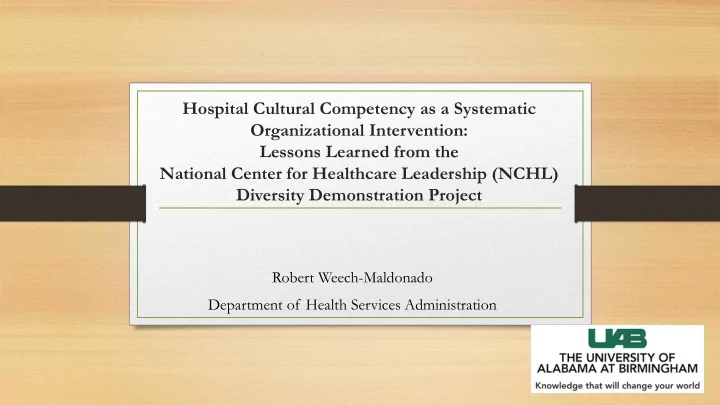

Hospital Cultural Competency as a Systematic Organizational Intervention: Lessons Learned from the National Center for Healthcare Leadership (NCHL) Diversity Demonstration Project Robert Weech-Maldonado Department of Health Services Administration
Research Team Judith Gail, MSOD, Diversity Coach Health Industry & Corporate Janice L. Dreachslin, PhD, Principal Investigator Professor Emerita of Health Policy & Administration, Penn State Greater Valley Rob Weech-Maldonado, PhD, Co-Principal Investigator Professor, L. R. Jordan Endowed Chair in Health Services Administration, University of Alabama at Birmingham Josue Epane, PhD, Co-Investigator Assistant Professor, University of Nevada, Las Vegas 2
Cultural Competency/Health Systems Focus • “Ongoing capacity of health- care systems” to provide for high quality care to diverse patient populations (NQF, 2008). • Cultural competency achieved through policies, learning processes, and structures by which organizations and individuals develop the attitudes, behaviors, and systems that are needed for effective cross-cultural interactions (Betancourt et al., 2003). • Successful implementation of cultural competency requires an organizational commitment towards a systems approach
Study Contribution • Weech-Maldonado et al. (2012) found a positive relationship between hospital cultural competency (adherence to CLAS) and HCAHPS scores in California hospitals • Few studies have examined the impact of systematic, organizational-level cultural competency interventions on hospital performance metrics • This demonstration project makes a contribution by: • Using a pre-post intervention assessment to explore the impact of a systematic and multi-faceted, and organizational-level cultural competency initiative on performance metrics at the organizational and individual levels among two health systems.
Figure 1: Conceptual Framework Organizational Level Competencies: Diversity Leadership - Strategic Human Resource - Management Patient Cultural Competency - Organizational Outcomes: Diversity Climate - Workforce Diversity Systematic Diversity Intervention - Individual Level Competencies: Diversity Self-awareness - Implicit Biases - Racial/ethnic identity -
Figure 2: Diversity Demonstration Project Intervention Flow Diagram
Participating Health Systems East Coast USA Two health systems with two participating hospitals/system - Random assignment of a control and intervention hospital in each health system - Matched on size, workforce, community demographics, service line - Interventions focused on C-Suite leadership and staff from one medical/surgical unit in the intervention hospitals Demographics - Predominately white service areas - Experiencing increases in patient religious, ethnic, and racial diversity
Major Findings • Intervention hospitals experienced • Improvements in the organizational-level competencies of diversity leadership and strategic human resource management. • Improvements were observed in the individual-level competencies for diversity attitudes and implicit bias for Blacks • Outperformed their respective control hospitals with respect to diversity climate. • Intervention Hospital X had stronger performance improvement than Intervention Hospital Y across most metrics of the study. • Although both hospitals experienced the same intervention, contextual differences may have impacted the implementation of the intervention. • Qualitative analysis shows that hospital X was more successful than hospital Y in the implementation of their organizational action plan as part of the intervention.
Differences between Systems Intervention Hospital X Intervention Hospital Y Influenced corporate Human Resources No formal consideration to diversity in to secure a diverse candidate pool prior the candidate pool to starting the interview process for the System has centralized responsibility for hospital all D&I initiatives Hospital continues to lead D&I initiatives Hospital-level diversity councils locally, with support from the system disbanded & replaced by systems level Hospital diversity council re-energized, Leadership team lacks racial and ethnic with new leadership, active participation diversity by the hospital president and systems- level support Leadership team racial/ethnic diversity 9
Implementation Barriers • Hospitals inundated by competing priorities delegated by their respective health systems • Huge resistance on nursing unit floor to participate • Percentage of respondents who completed both the pre and post-assessment ranged from a low of 7% to a high of 24% • Specific individual’s pre -post intervention change scores were not calculated. • Turnover issue • The relatively long intervention period of over two years • A shorter more focused intervention period may have produced better outcomes but was precluded by competing priorities in the health system.
Recommendations from Leadership Team • Maximum consideration should be paid to start-up of a project of this magnitude • Ensure adequate support resources are committed • Align the project with other major health systems initiatives & priorities • Directly involve health systems leadership in the project • If resources permit, engage entire hospital in initiative • Maintain diversity and cultural competence initiatives as a priority 11
Practical Implications • Focused and systematic approach to organizational change coupled with interventions that encourage individual growth and development may be an effective approach to building culturally competent health care organizations. • Any sustainable strategic diversity initiative must begin with executive leadership since organizational priorities are driven in large part through the perspective of those in leadership roles. • A strategic diversity initiative needs to be actively aligned with other hospital and health system initiatives for it to be effective.
Recommend
More recommend